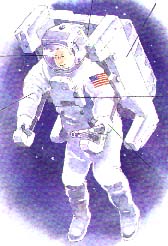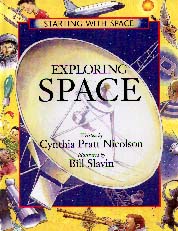|
________________
CM . . . .
Volume VII Number 16 . . . . April 13, 2001
excerpt: How does a space probe send data to Earth? A space probe uses radio signals to beam information to Earth. These signals are in the digital form computers use.  The seventh book in the "Starting with Space" series, with books by both Cynthia Pratt Nicolson
and Paulette Bourgeios, Exploring Space invites young readers to begin an adventure of
discovery into space. It focuses on developing scientific understanding and awareness of the
technology associated with the study of the universe. It provides introductory information on
topics such as the telescope, our galaxy, how rockets work, a space shuttle and many others.
The seventh book in the "Starting with Space" series, with books by both Cynthia Pratt Nicolson
and Paulette Bourgeios, Exploring Space invites young readers to begin an adventure of
discovery into space. It focuses on developing scientific understanding and awareness of the
technology associated with the study of the universe. It provides introductory information on
topics such as the telescope, our galaxy, how rockets work, a space shuttle and many others.
Science can be described as a method of finding out about the universe, and it begins with a child's curiosity about her/his world and questions that seek answers. Technology seeks to solve problems we encounter in adapting to and understanding our world. Exploring Space addresses both these aspects of learning about space. Young astronomers can begin a fascinating journey through legends, history, inventions, experiments, construction activities and well-answered questions to gain a new understanding and a growing sense of awe of the universe. The author provides young readers with a format that explores many aspects of space that will captivate and hold their interest. Each of the four chapters begins with a full page illustrated story that sets the stage for the theme of the chapter. Other pages contains questions on that topic plus well researched and clearly written answers as well as captioned pictures, NASA photographs or labeled diagrams. To support understanding of the concepts presented, there are step-by-step investigations, such as "Measure your moon strength" and "Make a two-stage rocket launcher," accompanied by simple explanations of the science behind each activity. For the fact lover, there is also a Space Data page. Explanations of the types of technology that have assisted in the exploration and understanding of space are also included in the chapters. A "space exploration timeline," a glossary and an index are other useful features of the book. The illustrator of several other books, such as The Kids' Guide to the Millenium, Bill Slavin creates drawings which add warmth and supporting detail to the text. Exploring Space will be a useful resource for school projects, for understanding and investigating the science and technology associated with the universe and for answering the many questions of junior astronomers. Highly Recommended. Janice Foster is a teacher-librarian in Winnipeg, MB.
To comment on this title or this review, send mail to cm@umanitoba.ca.
Copyright © the Manitoba Library Association.
Reproduction for personal use is permitted only if this copyright notice
is maintained. Any other reproduction is prohibited without
permission.
Published by
TABLE OF CONTENTS FOR THIS ISSUE - April 13, 2001.
AUTHORS |
TITLES |
MEDIA REVIEWS |
PROFILES |
BACK ISSUES |
SEARCH |
ORDER |
CMARCHIVE |
HOME
|
